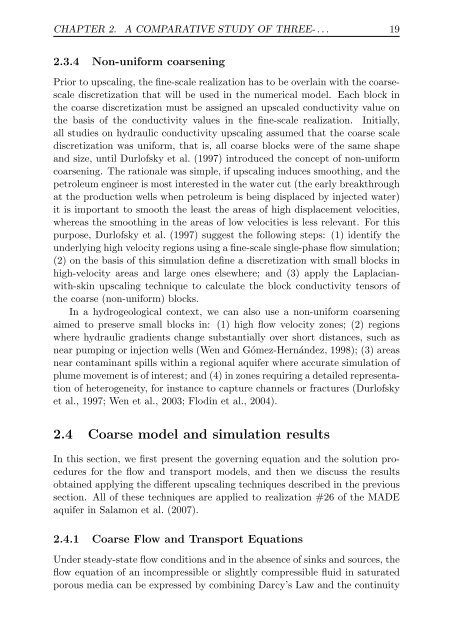Upscaling and Inverse Modeling of Groundwater Flow and Mass ...
Upscaling and Inverse Modeling of Groundwater Flow and Mass ...
Upscaling and Inverse Modeling of Groundwater Flow and Mass ...
You also want an ePaper? Increase the reach of your titles
YUMPU automatically turns print PDFs into web optimized ePapers that Google loves.
CHAPTER 2. A COMPARATIVE STUDY OF THREE- . . . 19<br />
2.3.4 Non-uniform coarsening<br />
Prior to upscaling, the fine-scale realization has to be overlain with the coarsescale<br />
discretization that will be used in the numerical model. Each block in<br />
the coarse discretization must be assigned an upscaled conductivity value on<br />
the basis <strong>of</strong> the conductivity values in the fine-scale realization. Initially,<br />
all studies on hydraulic conductivity upscaling assumed that the coarse scale<br />
discretization was uniform, that is, all coarse blocks were <strong>of</strong> the same shape<br />
<strong>and</strong> size, until Durl<strong>of</strong>sky et al. (1997) introduced the concept <strong>of</strong> non-uniform<br />
coarsening. The rationale was simple, if upscaling induces smoothing, <strong>and</strong> the<br />
petroleum engineer is most interested in the water cut (the early breakthrough<br />
at the production wells when petroleum is being displaced by injected water)<br />
it is important to smooth the least the areas <strong>of</strong> high displacement velocities,<br />
whereas the smoothing in the areas <strong>of</strong> low velocities is less relevant. For this<br />
purpose, Durl<strong>of</strong>sky et al. (1997) suggest the following steps: (1) identify the<br />
underlying high velocity regions using a fine-scale single-phase flow simulation;<br />
(2) on the basis <strong>of</strong> this simulation define a discretization with small blocks in<br />
high-velocity areas <strong>and</strong> large ones elsewhere; <strong>and</strong> (3) apply the Laplacianwith-skin<br />
upscaling technique to calculate the block conductivity tensors <strong>of</strong><br />
the coarse (non-uniform) blocks.<br />
In a hydrogeological context, we can also use a non-uniform coarsening<br />
aimed to preserve small blocks in: (1) high flow velocity zones; (2) regions<br />
where hydraulic gradients change substantially over short distances, such as<br />
near pumping or injection wells (Wen <strong>and</strong> Gómez-Hernández, 1998); (3) areas<br />
near contaminant spills within a regional aquifer where accurate simulation <strong>of</strong><br />
plume movement is <strong>of</strong> interest; <strong>and</strong> (4) in zones requiring a detailed representation<br />
<strong>of</strong> heterogeneity, for instance to capture channels or fractures (Durl<strong>of</strong>sky<br />
et al., 1997; Wen et al., 2003; Flodin et al., 2004).<br />
2.4 Coarse model <strong>and</strong> simulation results<br />
In this section, we first present the governing equation <strong>and</strong> the solution procedures<br />
for the flow <strong>and</strong> transport models, <strong>and</strong> then we discuss the results<br />
obtained applying the different upscaling techniques described in the previous<br />
section. All <strong>of</strong> these techniques are applied to realization #26 <strong>of</strong> the MADE<br />
aquifer in Salamon et al. (2007).<br />
2.4.1 Coarse <strong>Flow</strong> <strong>and</strong> Transport Equations<br />
Under steady-state flow conditions <strong>and</strong> in the absence <strong>of</strong> sinks <strong>and</strong> sources, the<br />
flow equation <strong>of</strong> an incompressible or slightly compressible fluid in saturated<br />
porous media can be expressed by combining Darcy’s Law <strong>and</strong> the continuity


